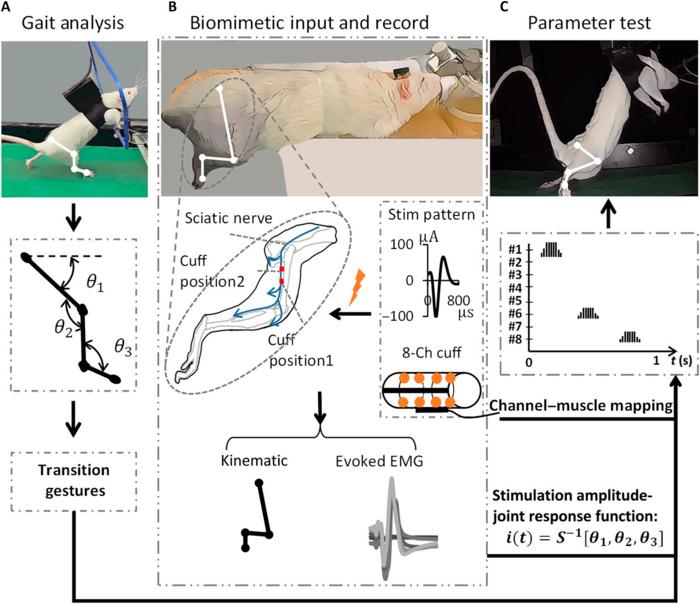A research paper by scientists at Beijing Institute of Technology presented a sciatic nerve stimulation method that will aid in lower extremity standing and stepping.

Credit: Yiran Lang, School of Life Science, Beijing Institute of Technology.
A research paper by scientists at Beijing Institute of Technology presented a sciatic nerve stimulation method that will aid in lower extremity standing and stepping.
The new research paper, published on Jul. 04 in the journal Cyborg and Bionic Systems, used the electrical nerve stimulation method and achieved muscle control via different sciatic nerve branches to facilitate the regulation of lower limb movements during stepping and standing.
Peripheral nerve stimulation is an effective neuromodulation method in patients with lower extremity movement disorders caused by stroke, spinal cord injury, or other diseases. However, most current studies on rehabilitation using sciatic nerve stimulation focus solely on ankle motor regulation through stimulation of common peroneal and tibial nerves. Consequently, Using the electrical nerve stimulation method, we here achieved muscle control via different sciatic nerve branches to facilitate the regulation of lower limb movements during stepping and standing. “A map of relationships between muscles and nerve segments was established to artificially activate specific nerve fibers with the biomimetic stimulation waveform. Then, characteristic curves depicting the relationship between neural electrical stimulation intensity and joint control were established. Finally, by testing the selected stimulation parameters in anesthetized rats, we confirmed that single-cathode extraneural electrical stimulation could activate combined movements to promote lower limb movements.” explained study author Yiran Lang, a professor at Beijing Institute of Technology. In addition, “This method is effective and reliable for use in treatment for improving and rehabilitating lower limb motor dysfunction.” said the study authors.
The study authors indicated that the classic multichannel cuff electrodes were used to perform extraneural electrical stimulation of the sciatic nerve of 6 rats, thereby precisely controlling multiple effective lower limb movements of the rats to regulate these movements in the unconscious state. Through single-point cathodal stimulation, we could accurately control the knee and ankle joint actions and generate compound knee–ankle and hip–knee–ankle joint movements based on different stimulation intensities. By analyzing the joint motion data, the characteristic sigmoid function relationship between the stimulation intensity and joint changes was verified, thereby allowing us to reverse engineer the function of intensity changes and achieve the goal of predefined trajectory control under specified joint movement conditions. In parameter testing, the effects of stimulation parameters and the combination of stimulation intensities and durations, which were selected based on the channel–joint mapping and the sigmoid function, were estimated. “Therefore, sciatic nerve electrical stimulation can accurately modulate hindlimb joint activity in anesthetized rats. When the stimulation intensity is adjusted, coordinated contraction effects can be achieved at hip, knee, and ankle joints, thereby effectively controlling the joint movements,” said Pengcheng Xi.
Successful results were obtained in hindlimb motion modulation because the sciatic nerve has a large diameter and exhibited clear functional division and the extrafascicular electrode was in a good working state. However, some limitations of our experiment remain. “On one hand, sciatic nerve electrical stimulation has limited control over the hip joint. To perfectly control the lower limb movement, neural stimulation from other areas must be combined. On the other hand, single-cathode nerve electrical stimulation offers good advantages in regulating compound movements but exhibits an average performance in precise control of single joints. Finally, parameter optimization based on sciatic nerve regulation is complex. Developing an optimization algorithm would therefore be more effective in facilitating safety exploration.” said Pengcheng Xi.
Authors of the paper include Pengcheng Xi, Qingyu Yao, Yafei Liu, Jiping He, Rongyu Tang, Yiran Lang
This work was supported by Tis work was supported by National Key R&D Program of China (grant nos. 2018YFB1307301 and 2017YFE0117000).
The paper, “Biomimetic Peripheral Nerve Stimulation Promotes the Rat Hindlimb Motion Modulation in Stepping: An Experimental Analysis” was published in the journal Cyborg and Bionic Systems on Jul 04, 2024, at DOI: 10.34133/cbsystems.0131.
Journal
Cyborg and Bionic Systems



